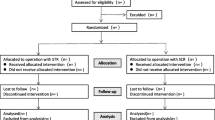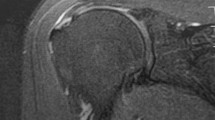Abstract
Purpose
The aim of the study was to evaluate whether arthroscopic (ASC) repair of rotator cuff ruptures causes less postoperative pain and better range of motion (ROM) in the early postoperative period than a mini-open (MO) technique.
Methods
Inclusion criteria were a rupture of the supraspinatus tendon with retraction with a maximum to the apex of the humeral head and minor fatty degeneration and atrophy of the muscle. Each group (n = 17) had similar demographics and preoperative magnetic resonance imaging (MRI) findings (mean age 60.1 years, SD 8.8, range 43–71). The ASC group underwent double-row repair with resorbable anchors; the MO group received a transosseous repair. The postoperative rehabilitation was standardised and equivalent in both groups.
Results
In the first week fewer nonsteroidal anti-inflammatory drug (NSAID) tablets were needed in the ASC group. Pain scores on the visual analogue scale were similar in the first three weeks; however, from week four to eight the MO group had less pain (p < 0.05). After six months, the Constant-Murley score and the ROM improved significantly (p < 0.05) in both groups without differences between the groups. Postoperative MRI revealed in three of 16 patients a discontinuity of the tendon in both groups; in the ASC group there were more patients (n = 9) with a thinning of the tendon compared to the MO group (n = 6).
Conclusions
There was less use of NSAIDs in the first postoperative week in the ASC group, indirectly indicating less pain, but higher pain scores in the later course (weeks four to eight) compared to the MO group. ROM, MRI findings and the scores were similar after six months, demonstrating that both techniques are equivalent regarding the outcome in this period.








Similar content being viewed by others
References
Boileau P, Brassart N, Watkinson DJ, Carles M, Hatzidakis AM, Krishnan SG (2005) Arthroscopic repair of full-thickness tears of the supraspinatus: does the tendon really heal? J Bone Joint Surg Am 87:1229–1240
Kim SH, Ha KI, Park JH, Kang JS, Oh SK, Oh I (2003) Arthroscopic versus mini-open salvage repair of the rotator cuff tear: outcome analysis at 2 to 6 years’ follow-up. Arthroscopy 19:746–754
Lafosse L, Brozska R, Toussaint B, Gobezie R (2007) The outcome and structural integrity of arthroscopic rotator cuff repair with use of the double-row suture anchor technique. J Bone Joint Surg Am 89:1533–1541
Lichtenberg S, Liem D, Magosch P, Habermeyer P (2006) Influence of tendon healing after arthroscopic rotator cuff repair on clinical outcome using single-row Mason-Allen suture technique: a prospective, MRI controlled study. Knee Surg Sports Traumatol Arthrosc 14:1200–1206
Sauerbrey AM, Getz CL, Piancastelli M, Iannotti JP, Ramsey ML, Williams GR Jr (2005) Arthroscopic versus mini-open rotator cuff repair: a comparison of clinical outcome. Arthroscopy 21:1415–1420
Yamaguchi K, Ball CM, Galatz LM (2001) Arthroscopic rotator cuff repair: transition from mini-open to all-arthroscopic. Clin Orthop Relat Res 390:83–94
Yamaguchi K, Levine WN, Marra G, Galatz LM, Klepps S, Flatow EL (2003) Transitioning to arthroscopic rotator cuff repair: the pros and cons. Instr Course Lect 52:81–92
Motycka T, Kriegleder B, Landsiedl F (2001) Results of open repair of the rotator cuff–a long-term review of 79 shoulders. Arch Orthop Trauma Surg 121:148–151
Cofield RH, Parvizi J, Hoffmeyer PJ, Lanzer WL, Ilstrup DM, Rowland CM (2001) Surgical repair of chronic rotator cuff tears. A prospective long-term study. J Bone Joint Surg Am 83-A:71–77
Verma NN, Dunn W, Adler RS, Cordasco FA, Allen A, MacGillivray J, Craig E, Warren RF, Altchek DW (2006) All-arthroscopic versus mini-open rotator cuff repair: a retrospective review with minimum 2-year follow-up. Arthroscopy 22:587–594
Warner JJ, Tétreault P, Lehtinen J, Zurakowski D (2005) Arthroscopic versus mini-open rotator cuff repair: a cohort comparison study. Arthroscopy 21:328–332
Youm T, Murray DH, Kubiak EN, Rokito AS, Zuckerman JD (2005) Arthroscopic versus mini-open rotator cuff repair: a comparison of clinical outcomes and patient satisfaction. J Shoulder Elbow Surg 14:455–459
Colegate-Stone T, Allom R, Tavakkolizadeh A, Sinha J (2009) An analysis of outcome of arthroscopic versus mini-open rotator cuff repair using subjective and objective scoring tools. Knee Surg Sports Traumatol Arthrosc 17:691–694
Millar NL, Wu X, Tantau R, Silverstone E, Murrell GA (2009) Open versus two forms of arthroscopic rotator cuff repair. Clin Orthop Relat Res 467:966–978
Buess E, Steuber KU, Waibl B (2005) Open versus arthroscopic rotator cuff repair: a comparative view of 96 cases. Arthroscopy 21:597–604
Severud EL, Ruotolo C, Abbott DD, Nottage WM (2003) All-arthroscopic versus mini-open rotator cuff repair: a long-term retrospective outcome comparison. Arthroscopy 19:234–238
Rickert M, Witzel U, Kölbel R, Georgousis H (2002) Primary strength of conventional and alternative suture techniques of the rotator cuff. A biomechanical study. Unfallchirurg 105:23–30
Schneeberger AG, von Roll A, Kalberer F, Jacob HA, Gerber C (2002) Mechanical strength of arthroscopic rotator cuff repair techniques: an in vitro study. J Bone Joint Surg Am 84-A:2152–2160
Park MC, Cadet ER, Levine WN, Bigliani LU, Ahmad CS (2005) Tendon-to-bone pressure distributions at a repaired rotator cuff footprint using transosseous suture and suture anchor fixation techniques. Am J Sports Med 33:1154–1159
Churchill RS, Ghorai JK (2010) Total cost and operating room time comparison of rotator cuff repair techniques at low, intermediate, and high volume centers: mini-open versus all-arthroscopic. J Shoulder Elbow Surg 19:716–721
Köse KC, Tezen E, Cebesoy O, Karadeniz E, Guner D, Adiyaman S, Demirtas M (2008) Mini-open versus all-arthroscopic rotator cuff repair: comparison of the operative costs and the clinical outcomes. Adv Ther 25:249–259
Sano H, Yamashita T, Wakabayashi I, Itoi E (2007) Stress distribution in the supraspinatus tendon after tendon repair: suture anchors versus transosseous suture fixation. Am J Sports Med 35:542–546
Tuoheti Y, Itoi E, Yamamoto N, Seki N, Abe H, Minagawa H, Okada K, Shimada Y (2005) Contact area, contact pressure, and pressure patterns of the tendon-bone interface after rotator cuff repair. Am J Sports Med 33:1869–1874
Meier SW, Meier JD (2006) The effect of double-row fixation on initial repair strength in rotator cuff repair: a biomechanical study. Arthroscopy 22:1168–1173
Cofield RH (1985) Rotator cuff disease of the shoulder. J Bone Joint Surg Am 67:974–979
Patte D (1990) Classification of rotator cuff lesions. Clin Orthop Relat Res 254:81–86
Fuchs B, Gilbart MK, Hodler J, Gerber C (2006) Clinical and structural results of open repair of an isolated one-tendon tear of the rotator cuff. J Bone Joint Surg Am 88:309–316
Thomazeau H, Rolland Y, Lucas C, Duval JM, Langlais F (1996) Atrophy of the supraspinatus belly. Assessment by MRI in 55 patients with rotator cuff pathology. Acta Orthop Scand 67:264–268
Sugaya H, Maeda K, Matsuki K, Moriishi J (2005) Functional and structural outcome after arthroscopic full-thickness rotator cuff repair: single-row versus dual-row fixation. Arthroscopy 21:1307–1316
Sampson TG, Nisbet JK, Glick JM (1991) Precision acromioplasty in arthroscopic subacromial decompression of the shoulder. Arthroscopy 7:301–307
Lafosse L, Van Raebroeckx A, Brzoska R (2006) A new technique to improve tissue grip: “the lasso-loop stitch”. Arthroscopy 22:1246.e1–1246.e3
Constant CR, Murley AH (1987) A clinical method of functional assessment of the shoulder. Clin Orthop Relat Res 214:160–164
Yanagisawa K, Hamada K, Gotoh M, Tokunaga T, Oshika Y, Tomisawa M, Lee YH, Handa A, Kijima H, Yamazaki H, Nakamura M, Ueyama Y, Tamaoki N, Fukuda H (2001) Vascular endothelial growth factor (VEGF) expression in the subacromial bursa is increased in patients with impingement syndrome. J Orthop Res 19:448–455
Ko JY, Wang FS, Huang HY, Wang CJ, Tseng SL, Hsu C (2008) Increased IL-1beta expression and myofibroblast recruitment in subacromial bursa is associated with rotator cuff lesions with shoulder stiffness. J Orthop Res 26:1090–1097
Blaine TA, Kim YS, Voloshin I, Chen D, Murakami K, Chang SS, Winchester R, Lee FY, O’Keefe RJ, Bigliani LU (2005) The molecular pathophysiology of subacromial bursitis in rotator cuff disease. J Shoulder Elbow Surg 14:84S–89S
Gotoh M, Hamada K, Yamakawa H, Yanagisawa K, Nakamura M, Yamazaki H, Ueyama Y, Tamaoki N, Inoue A, Fukuda H (2001) Interleukin-1-induced subacromial synovitis and shoulder pain in rotator cuff diseases. Rheumatology (Oxford) 40:995–1001
Morse K, Davis AD, Afra R, Kaye EK, Schepsis A, Voloshin I (2008) Arthroscopic versus mini-open rotator cuff repair: a comprehensive review and meta-analysis. Am J Sports Med 36:1824–1828
Osti L, Papalia R, Paganelli M, Denaro E, Maffulli N (2010) Arthroscopic vs mini-open rotator cuff repair. A quality of life impairment study. Int Orthop 34:389–394
Ide J, Maeda S, Takagi K (2005) A comparison of arthroscopic and open rotator cuff repair. Arthroscopy 21:1090–1098
Mohtadi NG, Hollinshead RM, Sasyniuk TM, Fletcher JA, Chan DS, Li FX (2008) A randomized clinical trial comparing open to arthroscopic acromioplasty with mini-open rotator cuff repair for full-thickness rotator cuff tears: disease-specific quality of life outcome at an average 2-year follow-up. Am J Sports Med 36:1043–1051
Funding
This work was supported by the research fund of the Orthopaedic Surgery Hospital of the University of Heidelberg. The local Ethics Committee approved the study (No. S-265/2007) and all patients consented to the study.
Conflict of interest
The authors declare that they have no conflict of interest.
Author information
Authors and Affiliations
Corresponding author
Additional information
Level of evidence
Level III treatment study
Rights and permissions
About this article
Cite this article
Kasten, P., Keil, C., Grieser, T. et al. Prospective randomised comparison of arthroscopic versus mini-open rotator cuff repair of the supraspinatus tendon. International Orthopaedics (SICOT) 35, 1663–1670 (2011). https://doi.org/10.1007/s00264-011-1262-2
Received:
Accepted:
Published:
Issue Date:
DOI: https://doi.org/10.1007/s00264-011-1262-2




